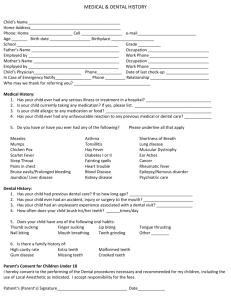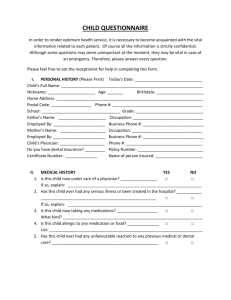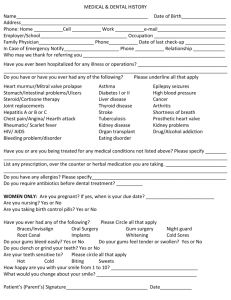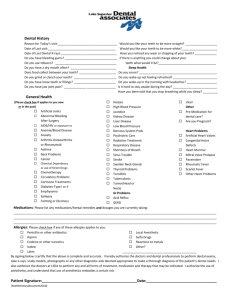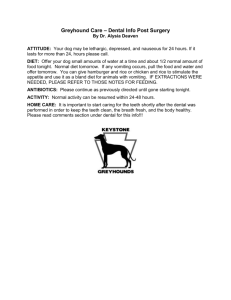2003.36 - DENT 165 (modification)
advertisement
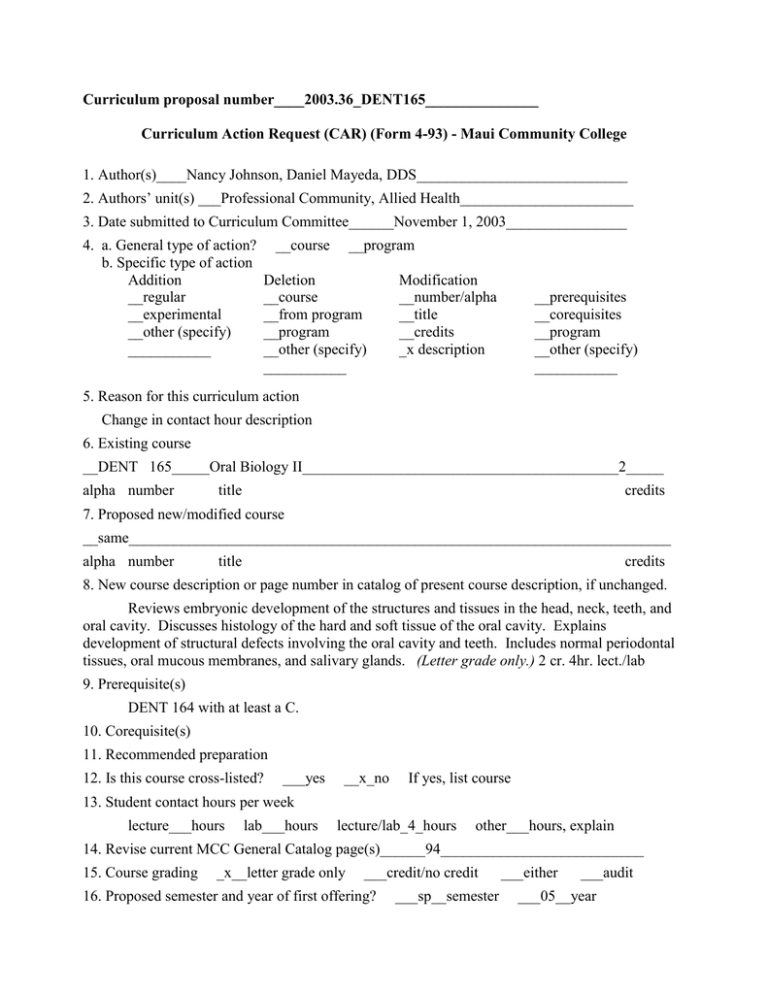
Curriculum proposal number____2003.36_DENT165_______________ Curriculum Action Request (CAR) (Form 4-93) - Maui Community College 1. Author(s)____Nancy Johnson, Daniel Mayeda, DDS____________________________ 2. Authors’ unit(s) ___Professional Community, Allied Health_______________________ 3. Date submitted to Curriculum Committee______November 1, 2003________________ 4. a. General type of action? b. Specific type of action Addition __regular __experimental __other (specify) ___________ __course __program Deletion __course __from program __program __other (specify) ___________ Modification __number/alpha __title __credits _x description __prerequisites __corequisites __program __other (specify) ___________ 5. Reason for this curriculum action Change in contact hour description 6. Existing course __DENT 165_____Oral Biology II__________________________________________2_____ alpha number title credits 7. Proposed new/modified course __same________________________________________________________________________ alpha number title credits 8. New course description or page number in catalog of present course description, if unchanged. Reviews embryonic development of the structures and tissues in the head, neck, teeth, and oral cavity. Discusses histology of the hard and soft tissue of the oral cavity. Explains development of structural defects involving the oral cavity and teeth. Includes normal periodontal tissues, oral mucous membranes, and salivary glands. (Letter grade only.) 2 cr. 4hr. lect./lab 9. Prerequisite(s) DENT 164 with at least a C. 10. Corequisite(s) 11. Recommended preparation 12. Is this course cross-listed? ___yes __x_no If yes, list course 13. Student contact hours per week lecture___hours lab___hours lecture/lab_4_hours other___hours, explain 14. Revise current MCC General Catalog page(s)______94___________________________ 15. Course grading _x__letter grade only ___credit/no credit 16. Proposed semester and year of first offering? ___sp__semester ___either ___audit ___05__year 17. Maximum enrollment_____ Rationale, if applicable 18. Special scheduling considerations? 19. Special fees required? __yes __yes __no _x_no If yes, explain. If yes, explain. 20. Will this request require special resources (personnel, supplies, etc.?) __yes _x_no If yes, explain. 21. Is this course restricted to particular room type? 22. __yes _x_no If yes, explain. _x_Course fulfills requirement for ____dental assisting__________ program/degree __Course is an elective for __________________________________ program/degree __Course is elective for AA degree 23. This course __increases __decreases _x_makes no change in number of credit required for the program(s) affected by this action 24. Is this course taught at another UH campus? __yes _x_no a. If yes, specify campus, course, alpha and number b. If no, explain why this course is offered at MCC 25. a. Course is articulated at __UHCC __UH Manoa __UH Hilo __UH WO __Other/PCC b. Course is appropriate for articulation at __UHCC __UH Manoa __UH Hilo __UH WO __Other/PCC c. Course is not appropriate for articulation at __UHCC __UH Manoa __UH Hilo __UH WO __Other/PCC d. Course articulation information is attached? __yes __no ....................................................................... Proposed by Approved by ___Nancy Johnson________________ Author or Program Coordinator/Date _________________________________ Academic Senate Chair/Date Requested by ____Kate Acks____________________ Division or Unit Chair/Date _________________________________ Chief Academic Officer/Date Recommended by _________________________________ Curriculum Chair/Date Revised Sept 2003/AC _________________________________ Chancellor/Date MAUI COMMUNITY COLLEGE COURSE OUTLINE 1. COURSE TITLE: DENT 165 Oral Biology II NUMBER OF CREDITS: Two credits (2) ABBREVIATED COURSE TITLE: ORAL BIOLOGY II DATE OF OUTLINE November 24, 2003 2. COURSE DESCRIPTION: Reviews embryonic development of the structures and tissues in the head, and neck. Discusses histology of the hard and soft tissues of the oral cavity. Explains the development of the structural defects involving the oral cavity and the teeth. Differentiates characteristics of normal and abnormal periodontal tissues, oral mucous membranes, and salivary glands. Introduces pharmacology of agents used in dentistry. 2 cr., 4hr Lec/Lab 3. CONTACT HOURS PER WEEK: 4. PREREQUISITES: Lec/Lab (4) DENT 164 with C or better COREQUISITE(S): RECOMMENDED PREPARATION: none APPROVED BY ______________________________ Date__________________ 5. GENERAL COURSE OBJECTIVES: Differentiate normal and abnormal oral structures. Identify common abnormalities and infections. Describe transmission and control of infective and contagious diseases. Describe pharmacology of local anesthetic solutions, analgesic gases, and psychosedatives, and antibiotic agents. 6. SPECIFIC COURSE COMPETENCIES: Upon successful completion of DENT 165, the student will be able to: Define the terminology used in naming the landmarks of teeth. Evaluate the importance of the shape of the teeth in regard to their fundamental and preventive curvatures. Describe microscopic features of enamel, dentin, cementum, and pulp. Differentiate the systems used to code teeth. Explain occlusion and identify the three occlusal classifications. Define the various anomalies of teeth. List and describe common developmental defects involving non-dental oral structures and defects involving the teeth. Describe and define the process of inflammation, regeneration, repair and healing. List the most common dental infections and describe their course, treatment, and resolution. Carve a maxillary incisor and a mandibular molar Describe diagnostic tools used in dental practice Describe basic pharmacology of selected local anesthetic solutions, analgesic gases, and psychosedatives, and antibiotic agents. 7. RECOMMENDED COURSE CONTENT AND APPROXIMATE TIME SPENT 3 weeks Maturation of the hard dental tissues including landmarks of teeth and systems for coding teeth Microscopic features of enamel, dentin, cementum and pulp 1 week Development of the gingiva, epithelial attachment, periodontal, ligament and alveolar bone. 4 weeks Introduction to principles of oral pathology. Process associated with the development of abnormalities and defects in the oral and dental structures including fundamental and curvatures; and occlusal classifications preventive 3 weeks Inflammation, repair, regeneration, healing, and dental infections including course, treatment, and resolution 2 weeks Basic pharmacology of selected local anesthetic solutions, analgesic gases, and psychosedatives, and antibiotic agents. 2 weeks Diagnostic tools in oral pathology. 8. RECOMMENDED COURSE REQUIREMENTS Specific course requirements are at the discretion of the instructor at the time the course is being offered. Suggested requirements might include, but are not limited to, the following Attendance Group projects and presentations Quizzes and Exams Laboratory Practical 9. TEXT AND MATERIALS Text materials will be selected from the best and most up-to-date materials available, such as Brand and Isselhard, Anatomy of Orofacial Structures, current edition, C.V. Mosby. Bird, D. et al, Torres and Ehrich Modern Dental Assisting, current edition, W.B. Saunders Co; ISBN: 0721695299. Torres, Hazel, Modern Dental Assisting: Workbook, current edition, W.B. Saunders Co; ISBN: 0721676294. Miller and Keane, Encyclopedia and Dictionary of Medicine, Nursing and Allied Health, current edition, Saunders. Massler and Schour, Atlas of the Mouth, current edition, American Dental Association. Finkbeiner, Betty L, Four-Handed Dentistry: A Handbook of Clinical Application and Erogonomic Concepts, current edition, Prentice Hall; ISBN: 0130304131. 10. EVALUATION AND GRADING One or more midterm examinations, quizzes, and a final examination will be given. These tests may include any of the following types of questions: multiple choice, true-false; matching, short answer, short essay, and critical thinking. Exams will cover material from lectures, laboratory exercises, and reading assignments. Weekly quizzes Midterm examination Lab Assignments Final Exam 35% 20% 20% 25% 11. METHODS OF INSTRUCTION Lecture/Discussion Group Presentations Supervised Laboratory Practice


